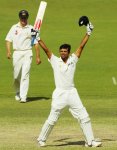-
Welcome to the Cricket Web forums, one of the biggest forums in the world dedicated to cricket.
You are currently viewing our boards as a guest which gives you limited access to view most discussions and access our other features. By joining our free community you will have access to post topics, respond to polls, upload content and access many other special features. Registration is fast, simple and absolutely free so please, join the Cricket Web community today!
If you have any problems with the registration process or your account login, please contact us.
Top 30 batsmen of the modern era (1990s -Current) - Updated
- Thread starter venkyrenga
- Start date
venkyrenga
U19 12th Man
venkyrenga
U19 12th Man
Awarding points for more balls faced (or even minutes) has the same overall effect as penalizing for a very high SR.No, but isn't that the logical conclusion of your theory? If you think the batsman's job is to stay longer out there, negatively penalizing their strike rate seems wrong, however you milk it. I think it would be easier to positively add to them for being out there longer.
Again there is a misunderstanding. Because that is not my theory. In fact it is the opposite of it.The theory that scoring runs at a faster rate is something bad for any team at any time in test cricket just seems extremely odd to me.
Of course the optimal SR cannot be the same for all the matches or batsmen. That's why I have given a 10% leeway from the optimal SR of 60 and made it 54-66. From my assessment of numerous matches and batsmen, which I did before starting this, the desirable SR is in that range unless you have some extreme exception where a batsman almost always played in very batting friendly or bowling friendly pitches.And how exactly do you define the bolded here in your methodology? I think the best example of the adaptability of a batsman to any condition is usually reflected in how many runs he scores.
Unless your methodology has a way of figuring out when a team were playing for a draw or something, but again I am not sure how we can justify a measure called optimal SR unless it is something that changes innings by innings and match by match.
honestbharani
Whatever it takes!!!
Sorry mate, I understand the hard work you have put it into this but honestly there is no such thing as a desirable SR range over a career. I would love to see your methodology with this factor removed. But with it, I am not sure it adds anything but it definitely subtracts quite a bit.the desirable SR is in that range unless you have some extreme exception where a batsman almost always played in very batting friendly or bowling friendly pitches.
Fuller Pilch
Hall of Fame Member
Yeah, I agree. Sometimes there are 'odd couples' batting together in terms of strike rate (one hare, one tortoise) but they bat together for the good of their team. In recent years we've seen NZ with Watling's very low strike rate paired with De Grandhomme's very high strike rate but both are going a job for their side. Likewise Pujara and Pant did this for India in Australia.
Last edited:
venkyrenga
U19 12th Man
The methodology does not penalize for scoring at a slower rate neither does it penalize for scoring at a faster rate. It only penalizes batsmen who always score slow or always score fast. Thereby rewarding batsmen who are capable of doing both.
I am glad to agree to disagree.Sorry mate, I understand the hard work you have put it into this but honestly there is no such thing as a desirable SR range over a career. I would love to see your methodology with this factor removed. But with it, I am not sure it adds anything but it definitely subtracts quite a bit.
Coronis
International Coach
RightioThe methodology does not penalize for scoring at a slower rate neither does it penalize for scoring at a faster rate. It only penalizes batsmen who always score slow or always score fast.
venkyrenga
U19 12th Man
venkyrenga
U19 12th Man
TheJediBrah
Request Your Custom Title Now!
You literally rate players lower for having a higher career strike rate lolAgain there is a misunderstanding. Because that is not my theory. In fact it is the opposite of it.
That is a ridiculous statement, and horrific logicNo matter which team a batsman plays for, in test cricket there will be situations where one will need to increase the scoring rate or slow down and occupy the crease for a long period. And if a batsman has adapted to these match conditions his overall SR would be in the optimal range and not extremely high or low. This is simple logic.
venkyrenga
U19 12th Man
venkyrenga
U19 12th Man
If we look at plain average Sanga would be higher. But his points are brought down by lower overseas average and quality of bowling faced in that period. Whereas Chanderpaul's points are increased by quality of bowling faced.I'm surprised to see De Villiers' peak points so much higher than Sangakkara's. And very surprised that Chanderpaul's peak is higher than Sangakkara's at all, even by only a little.
venkyrenga
U19 12th Man
venkyrenga
U19 12th Man
venkyrenga
U19 12th Man
venkyrenga
U19 12th Man
Azhar's performance since 90s wasn't enough to make it to this list. But if we considered his run in the 80s he would roughly earn about 117 pts which should put him close to no. 25.Despite of some flaws, I see there is mostly a plausible ranking which seems befitting to the players with not much shocking scrambles.
I would also like to know where would you rank someone like Md. Azharuddin.
I am also open to discuss whatever you feel as flaws in the system









